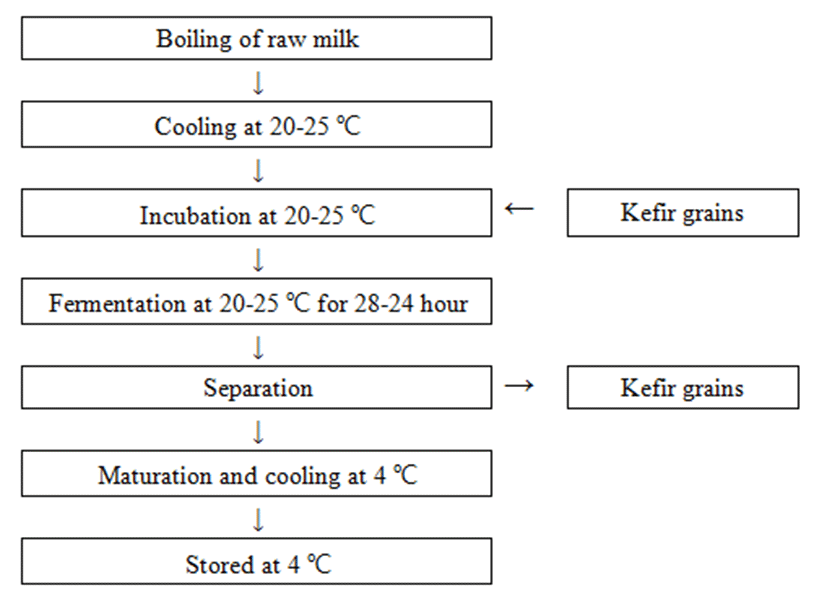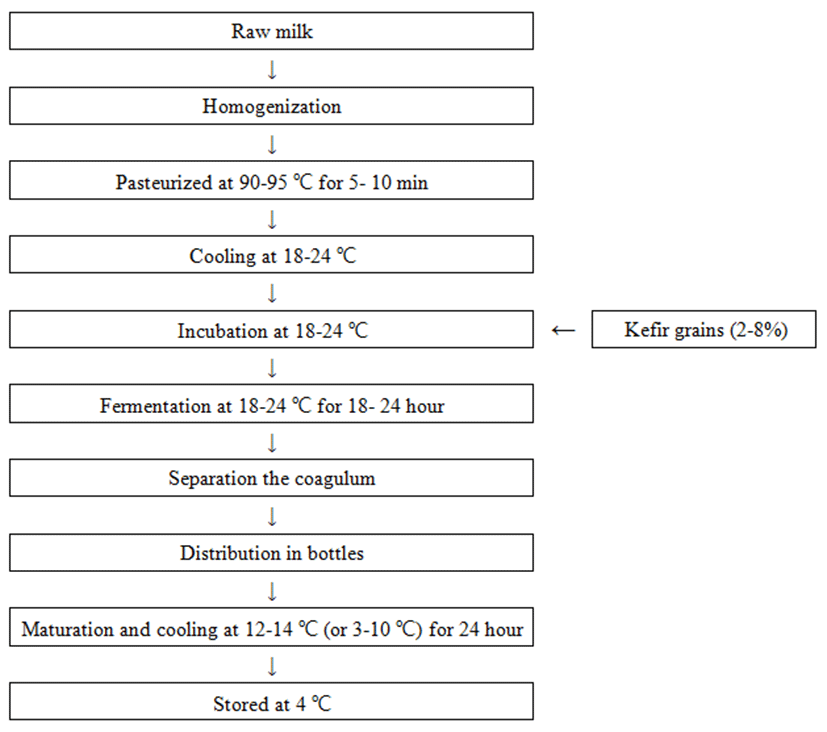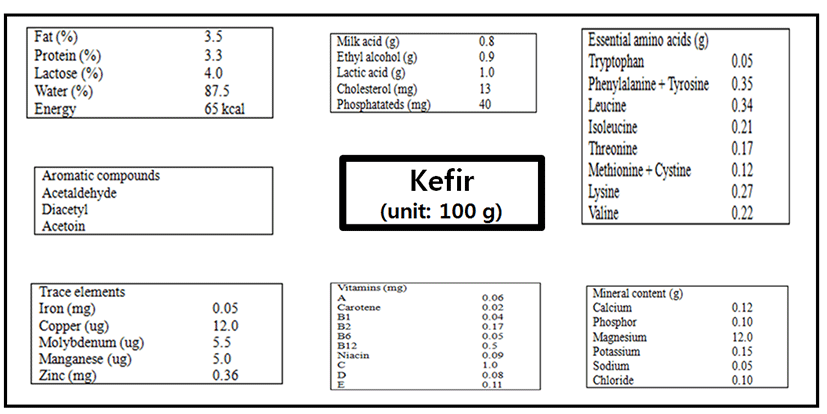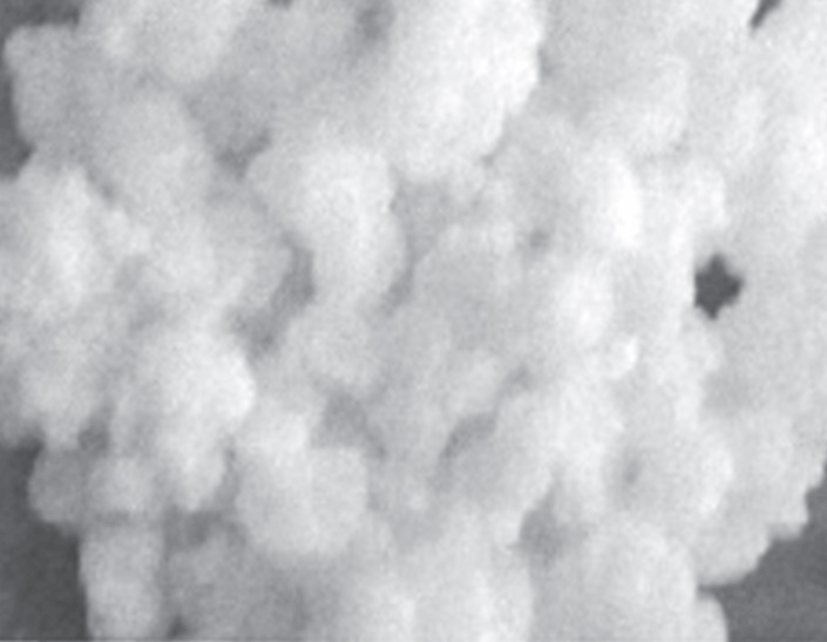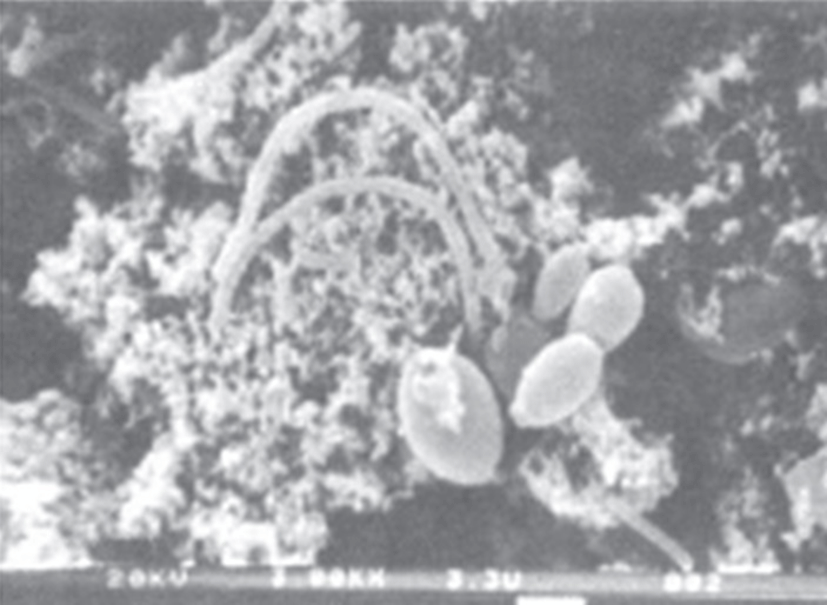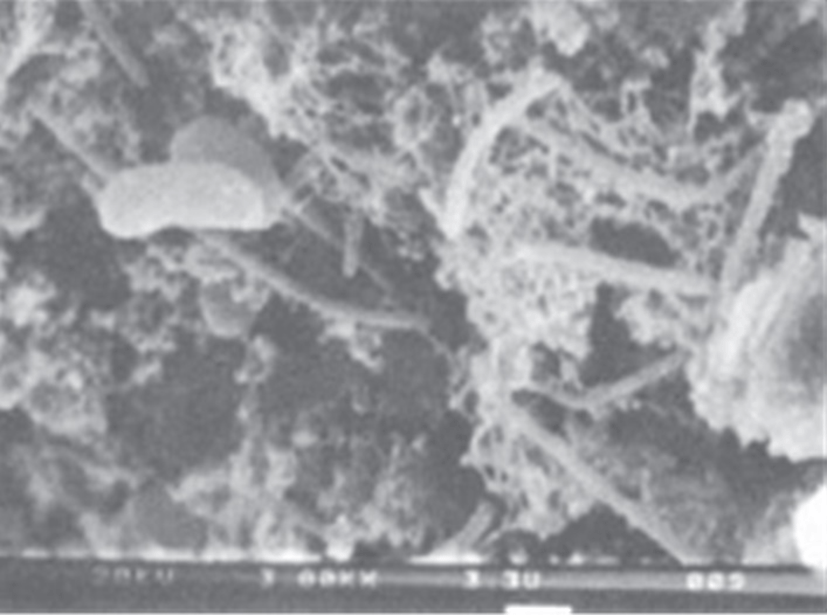Introduction
Kefir production is mainly based on fermentation of milk with starter kefir culture and kefir grains looks like little cauliflowers and contains a complex mixture of lactic acid bacteria, acetic acid bacteria and yeast Ot1es and Cagindi, 2003; Irigoyen et al., 2004; Powell, 2006; Chen et al., 2008; 周剑忠 et al., 2008; 王蕊 et al., 2009). The complex structure of microflora cause symbiotic relationship is responsible for fermentation (Maeda et al., 2004; 刘慧 et al., 2005). Thus, the purpose of this review paper was to suggest the basic information about kefir which had many function for improving human health. This review contacted kefir’s history, the current industrial status, kefir’s appearance including the descriptions about kefir grains, kefir’s overall functions and its production in China. All the materials have been reorganized in the published literature.
All about Kefir
The word kefir is derived from the Turkish word ‘keif’ which means ‘good feeling’. Kefir is known as a milk beverage of old world food. The drink originated in the Caucasus Mountains in the former Soviet Union, in Central Asia and has been consumed for thousands of years (Powell, 2006). The Caucasian people discovered that the fresh milk carried in leather pouches would occasionally ferment into an effervescent beverage (Irigoyen et al., 2004). In their countries the kefir until now has been produced primarily from sheep milk, whereas in Europe its production on a commercial scale is limited basically to cow milk (Wojtowski et al., 2003).
Besides that kefir originally spread through Russia, Eastern Europe, Middle East, the west Germany, Switzerland, and Northern Europe. Recently, kefir is also popularized in America, England, Canada, Japan, and so forth. For those countries which did not pay much attention on kefir, have shown exceeding interests at kefir recently. In particular, Germany will enlarge both the consumption and production of kefir in the future. In China, industry of kefir is still at the very beginning step, and the annual yield is less than 30,000 tons. Most kefir are predominantly imported (王蕊 et al., 2009).
Kefir differs from other fermented dairy products in that it is the product of fermentation of milk in the presence of a mixed group of microorganism confined to a matrix of discrete ‘kefir grains’, which can be recovered for subsequent fermentation (Chen et al., 2008). Kefir is fermented only by kefir grains and its mother culture, and kefir grains are the original contributor to kefir’s antimicrobial activity.
Kefir grain, is like small clusters of off-white gelatinous nodules. The grains are insoluble in water and common solvents, gelatinous, and irregular in size, varying from 0.3∼3.5 cm in diameter. Each grain contains symbiotic consortia of bacteria and yeasts held together by a matrix of proteins, lipids, and polysaccharides. This symbiosis is responsible for kefir’s mouthfeel’ s like tangy and stringy, and accounts for many of its health promoting and medicinal properties (Powell, 2006). These grains can be persevered by freezing, lyophilization, and refrigeration (Silva et al., 2009).
Kefiran is a water-soluble polysaccharide gel, which constitutes between 24∼25% (m/m) of the dry weight of the kefir grain. It is a matrix of fibrillar amorphous material. This fibrillar matrix surrounds the bacteria and yeast in kefir grains, and holds the grains together (Santos et al., 2003). Kefiran polysaccharide has antibacterial, antimycotic and antitumour activity (Micheli et al., 1999). It is also said that a number of Kefiran-producing homofermentative LAB have been isolated from kefir grains, including Lactobacillus kefir, Lactobacillus kefirnofaciens, Leuconostoc mesenteroides and Lactococcus lactis subsp. cremoris.
Kefiran has been studied extensively and has demonstrated anti-inflammatory and immunomodulating properties in animal and human trials. It has also demonstrated antibacterial and anti-mycotic properties (Diniz, 2003; Maeda et al., 2004).
For kefir is a natural probiotic, it contains live active cultures of normal flora which is made of very strong strains of microorganisms that help to over take pathogenic organisms, repopulate the digestive tract and aid in digestion. It also claims that consuming fermented milk foods can boost the immune system, alleviate symptoms of diarrhea and chronic constipation, and lower the risk of colon cancer (Ot1es and Cagindi, 2003).
The microbes in kefir grains are able to produce lactic acid, acetic acid, ethanol, peptides, and other biologically active components that increase the storage capability of milk and inhibit the growth of undesirable and pathogenic microbes (Witthuhn et al., 2005). There are data to show that many lactobacilli are capable of producing a wide range of antimicrobial compounds that may be used in the treatment and prevention of vaginal infections (Farnworth, 2005).
Some studies refer to kefir’s antimicrobial activity and suggest that the probiotic might influence the gastrointestinal disorders of humans, such as with ulcers and diarrhea (Jamuna and Jeevaratnam, 2004).
Yogurt contains transient beneficial bacteria that keep the digestive system clean and provide food for the friendly bacteria that reside there. But kefir can actually colonize the intestinal tract, a feat that yogurt cannot match. Kefir contains several major strains of friendly bacteria not commonly found in yogurt, Lactobacillus Caucasus,Leuconostoc, Acetobacter species, and Streptococcus species. Because the curd size of kefir is smaller than yogurt, it is also easier to digest, which makes it a particularly excellent, nutritious food for babies, the elderly and people experiencing chronic fatigue and digestive disorders.
Kefir can be made from any type of milk, cow, goat or sheep, coconut, rice or soy. Although it is slightly mucous forming, the mucous has a "clean" quality to it that creates ideal conditions in the digestive tract for the colonization of friendly bacteria.
There are several methods of producing kefir (Ot1es and Cagindi, 2003). Commonly traditional and industrial processes are used and also food scientists are currently studying modern techniques to produce a kefir with the same characteristics as those found in traditional kefir.
Here are the two basic types of processes:
the traditional method of kefir making involves the direct addition of kefir grains to milk, which has been pasteurised and cooled to between 200℃ and 250℃. Then, fermented in 18∼24 hours at 20∼250℃ (room temperature). After this, the grains are removed by filtering with a sieve and can be dried at room temperature and kept at cold surroundings for being used in the next inoculation. Kefir is stored at 40oC for a time then is ready for consumption. The traditional process of kefir is shown in Fig. 1.
this method is almost the same as traditional process. First, to homogenize the milk to 8% dry matter and held by heat treatment at 90∼95℃ for 5∼10 minutes. Then to cool at 18∼24℃ and inoculated with 2∼8% kefir cultures in tanks. It costs 18∼24 hours to ferment. The coagulum is separated by pomp and distributed in bottles. After maturing at 12∼14℃ or 3∼10℃ for 24 hours, kefir is stored at 4℃. The industrial process of kefir is shown in Fig. 2 (Ot1es and Cagindi, 2003).
The optimal conditions for kefir’s fermentation has been proved to be: fermenting temperature 23℃, incubating quantity 3%, time requirement 48h, concentration 12%. Incubating temperature is the primary factor which affects fermentative activity. Secondly, the milk concentration. Thirdly, the quantity of incubating kefir grains. At last, incubating time makes the least influence on fermentative activity (刘慧 et al., 2005).
Functions of Kefir
Owing to the probiotic microbial communities are different from the common yogurt, the physiological functions of its products are superior than the common yogurt. Kefir is rich in highly digestible lactoprotein and milk fat, in which probiotic microbial community hydrolyzes most of lactose in milk into human benefited L-lactic acid, with very little D-lactic acid formed. It claims that kefir contains 2∼5% D-lactic acid, which is further lower than that of common yogurt (contains about 25∼60% lactic acid). Since human body is lack of metabolic enzyme of lactate, ingesting D-lactic acid is more easy to suffer a acidic blood disease.
Therefore, kefir is a good diet for lactose intolerant individuals that have the inability to digest significant amounts of lactose that is the predominant sugar of milk (Ot1es and Cagindi, 2003).
Meanwhile, with the function of L-lactic acid, it also improves the absorbability of calcium, phosphorus, and iron. In addition, kefir is rich in water soluble vitamin B, like vitamin B1, vitamin B2, vitamin B6, vitamin B12, niacin, and folic acid. As a result, kefir is not only brings a high nutritional value, but also contribute to a better health and increasing longevity (王蕊 et al., 2009).
Researches also claimed about their curative properties and consumed that fermented milk foods can boost the immune system, alleviate symptoms of diarrhea and chronic constipation, and lower the risk of colon cancer have been popular, along with the perception that commercial yogurt and kefir are inferior to those fermented at home from natural starters (Lopitz-Ostoa et al., 2006). Probiotics found in kefir have stimulating effects on the immune system by improving phagocytosis and by increasing the numbers of T-lymphocytes and NK cells. They also have an indirect effect on the immune system by forming bioactive peptides in the process of fermentation (Heyman, 2000; Sanders, 2000).
Several studies have investigated the antitumor activity of kefir and polysaccharides form kefir grain (Cevikbas et al., 1994; Furukawa et al., 1990). And recent researches demonstrated that kefir has a better function of antiatheroscloresis and antidiabetics, and has the curative properties for tuberculosis. Besides, kefir contains capsular polysaccharide which inhibit the reproduction of cancer cells, so that reduce the incidence of cancer.
Kefir can also decrease contents of serum cholesterol, strengthen functions of liver and gall. Improving the functions of immune system and anti-aging. viable organism in kefir grains forcefully inhibit production of such bacteria, like Mycobacterium tuberculosis, Escherichia coli, Shigella, Salmonella. Therefore, frequently consumption of kefir can maintain a superiority of probiotic community within human’s gastrointestinal tract.
“ Revolution in bowels” mentions that “intestinal disease is the root of all diseases”. A healthy body should begin with healthy intestines. Consequently, the consumption of kefir in a frequent way, a superiority of probiotic in intestines can be retained, and reduce incidence of intestinal diseases, eventually obtain a healthy body and the aim of longevity.
The composition of kefir is variable and not well defined (Zubillaga et al., 2001). It depends on the source and the fat content of milk, the composition of the grains or cultures and the technological process of kefir. The chemical composition of kefir is shown in Fig. 3.
The nutrient composition of kefir is similar to that of milk, in addition to beneficial bacteria and yeast, kefir contains vitamins, minerals and essential amino acids that help the body with healing and maintenance functions. With kefir containing more vitamins B1, B2 and folic acid, kefir is also rich in vitamin K and amino acids and is an excellent source of biotin, a B vitamin that aids in the assimilation of the other B vitamins. The proteins in kefir are partially digested and are, therefore, more easily utilized. Tryptophan, one of the essential amino acids abundant in kefir, is well known for its relaxing effect on the nervous system. Kefir also offers an abundance of calcium and magnesium, which are important minerals for a healthy nervous system. The high phosphorous content contributes to the utilization of carbohydrates, fats, and proteins by the body for cell growth, maintenance and energy (Saloff-Coste, 1996).
Kefir is a good source of essential amino acids, vitamins, and minerals, which helps maintenance chemistry in our body (Fig. 3).
The numerous benefits of B vitamins are regulation of the kidneys, liver and nervous system to helping relieve skin disorders, boost energy and promote longevity (Ot1es and Cagindi, 2003). Propionibacteria may be added to the kefir grains to increase the vitamin B12 concentration of the beverage. This is beneficial as the presence of vitamin B12 in milk decrease as much as 95% during lactic acid fermentation. The microorganisms in kefir do not synthesize vitamin B12, but they stimulate its production in mixed culture in the presence of propionic acid bacteria. Van Wyk (2002) reported increases of vitamins B12 in kefir enriched with Propionibacterium freudenreichii subsp. shermanii.
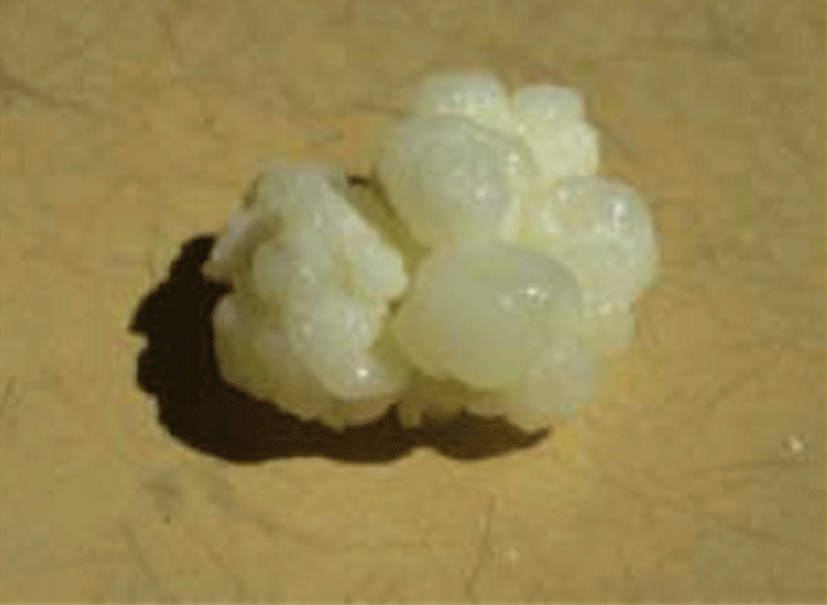
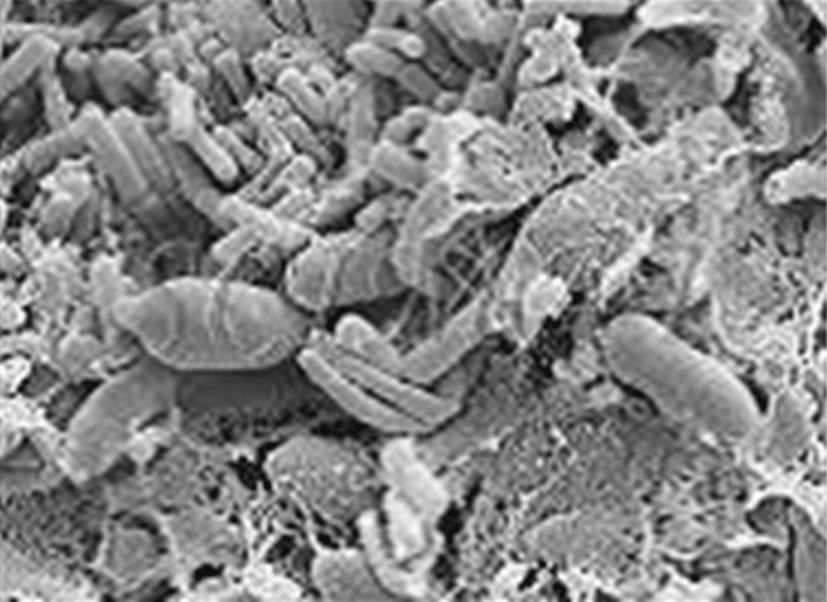
Antimicrobial Activity of Kefir
Kefir and sphingomyelin isolated from the lipids in kefir have been reported to stimulate the immune system in both in vitro and in vivo studies (Osada et al., 1994; Zacconi et al., 1995).
Kefir possesses antimicrobial activity in vitro against a wide variety of Gram-positive and Gram-negative bacteria, as well as some fungi (Garrote, 2000).
Differences in the genus, species or strain of probiotic bacteria can contribute to differences in traits such as stability, enzyme expression, carbohydrate fermentation patterns, acid production, and colonizing ability. The composition of kefir varies dramatically depending on a variety of factors, including the source of the milk, its fat content and the composition of the grains or starters.
Kefir grains include LAB (Lactobacilli, lactocci, Leuconostocs), yeasts, acetic acid bacteria and possibly other microorganisms. The predominant Lactobacilli in kefir grains are L. paracasei subsp. paracasei, L. acidophilus, L. delbrueckii subsp. bulgaricus, L. plantarum and L. kefiranofaciens. These strains account for 90% of the population in the grains, but only 20% of the Lactobacilli in the final fermented beverage. The remaining 80% of these LAB consists of L. kefir.
Here is the Table for microorganisms associated with kefir and kefir grains:
-
Lactic acid bacteria
-
Enterococcus durans
-
Lactobacillus kefiranofaciens
-
Leuconostoc mesenteriodes
-
Streptococcus salivarius
-
Acetic acid bacteria
-
Yeasts
-
Candida pseudotropicalis
-
Mycelial fungi
Some coliforms are actively inhibited by kefir microorganisms, and pathogenic bacteria such as Shigella and Salmonella do not grow when they are introduced to kefir. Of all the kefir starter microbial components, the microphilic homofermentative lactococci and acetic acid bacteria are the most active against coliforms. The microbes in kefir grains are able to produce lactic acid, acetic acid, ethanol, peptides, and other biologically active components that increase the storage capability of milk and inhibit the growth of undesirable and pathogenic microbes.
Van Wyk (2002) showed that kefir possesses an inhibitory activity against Staphylococcus aureus, Bacillus cereus, Escherichia coli, Clostridium tyrobutyricum and Listeria monocytogenes. Studies have also indicated that yeasts such as Torulaspora, when separated from kefir, possess pronounced antimicrobial activiry against coliforms (Powell, 2006).
The exact cause of the inhibition is not known, but may be due to the antagonistic action of various species of LAB (Lactic Acid Bacteria). Lactic acid bacteria are also capable of preventing the adherence, establishment, replication, and pathogenic action of certain enteropathogens. The precise mechanism of this antagonistic activity is not clear, but may include the activity of lactic acid or volatile acids, hydrogen peroxide, carbon dioxide, acetaldehyde and diacetyl, or bacteriocin and bacteriocin-like products. Supposedly, some inhibitory compounds of the kefir beverage, such as bacteriocins, hydrogen peroxide, and organic acids might be responsible for killing pathogenic microorganisms.
In addition, kefir might also promote competitive adhesion to the gastrointestinal epithelium surface (Ot1es and Cagindi, 2003). Lactobacillus isolated from kefir showed antimicrobial activity against Enterobacteria and verified that ingestion of kefir specifically lowered microbial populations of Enterbacteriaceae and Clostridia (Powell, 2006).
LAB must survive in the digestive system after they are consumed in order to produce any beneficial effects. It has been shown that Lactobacillus delbrueckii subsp. bulgaricus consumed in fermented milk products like yogurt and kefir do survive the passage through the upper gastrointestinal tract. Probiotics have been effective in the treatment of people with inadequate lactose digestion, as they convert the lactose in the lactic acid, rendering the milk they ferment almost lactose-free. Research has shown that probiotic can contribute to the general health of their host by resisting colonization of the digestive system by harmful microorganisms, contributing to the nutrition of the host, and affecting immunomodulation.
A decrease in the pH of the kefir beverage is caused by the accumulation of organic acids, primarily lactic acid and acetic acid, produced as major end-products of carbohydrate metabolism by LAB. Accumulation of lactic acid and a subsequent decrease in pH results in a broad-spectrum inhibitory activity against Gram-positive and Gram-negative bacteria.
The undissociated forms of lactic and acetic acid penetrates the microbial cell membrane. This results in acidification of the cytoplasm and the formation of inhibitions, especially against enzymes, by salt excesses. At a higher intracellular pH these acids dissociate to produce hydrogen ions, which interfere with important metabolic functions such as oxidative phosphorylation and substrate translocation. The antimicrobial effect of lactic or acetic acid depends on the pKa value of the acid, as well as the pH of the external environment. These acids are known to inhibit E. coli and B. cereus. At a pH 5.0, acetic acid inhibits the growth of Salmonellae typhimurium. A synergism between lactic and acetic acid has been reported for the inhibition of E. coli and Salmonella spp. (Garrote, 2000). Lactic acid is a stronger acid than acetic acid and in well-buffered foods with a pH of 4∼6, acetate has a stronger antimicrobial effect as a greater portion of the acid is undissociated.
Brown sugar was the most effective carbohydrate source with antimicrobial action, mainly against C. albicans, for kefir grains promoted the hydrolysis of non-reducing sugars, which are converted into organic acids and substances capable of producing inhibition halos with pathogenic microorganisms (Yuksekdag et al., 2004).
Kefir’s Research and Production in China
In China, there is such a kind yogurt that the production is very resemble to that of kefir’s. People immerse Tibetan kefir grains in milk, after acidification of the milk, separate the grains. Also, it claims that long time drinking Tibetan kefir beverage can boost people’s immune system, complement vitamins, retard aging, allay tiredness, particularly good for people who suffering a gastrosia, or nephropathy. This kind Tibetan kefir looks very similar to kefir grains. They are both off-white, colloidal lump, and there lives various microorganisms on the surfaces. Research has shown that compared microbial community structures of kefir and Tibetan kefir by using PCR-DGGE, bacteria community showed a 78∼84% similarity among different Tibetan kefir, and 50∼70% among kefir from different regions. DGGE profiles of yeast indicated 80∼92% similarity of yeast community among 3 Tibetan kefirs, and a 50∼75% similarity among kefir from different regions (周剑忠 et al., 2008).
According to Fig. 8 and Fig. 9, it is seen that compared with kefir grain, the microorganism density of the outer surface of Tibetan kefir grain is larger.
Kefir is an amazing yogurt, which is the secret of longevity in the Caucasus residents, because of its unique nutritional and health function abnormalities prevalent in foreign countries. However, kefir production in China is severely hampered. The reason is that kefir ferment on high-priced imports and the foreign agent produced by fermentation of kefir flavor and texture are not suitable for domestic consumption habits.
China’s large population, the demand for fermented health drinks straight up, while China’s current annual sales of kefir beverages is less than small countries such as Sweden and Finland, mainly due to kefir ferment rely on imports, prices high, a single species and fermentation, the impact of active instability.
There are many companies produced new kefir fermentation agent industrialization, which both lowered the price of kefir and produced high quality that can be comparable to foreign products. Plus kefir can be easily made at home. Therefore, an effective solution to the foreign monopolies, import prices are too high and fermented beverages are not suitable for Chinese tastes and so on. Consequently, it will promote the industrialization of kefir in China.
Conclusion
Kefir’s high nutritional values, containing about tryptophan, minerals, and vitamins, which help human body get rid of many diseases. Such as intestinal diseases, cancer, etc. Due to the microorganisms living on the surface of kefir grain, kefir possesses an inhibitory activity against Staphylococcus aureus, Bacillus cereus, Escherichia coli, Clostridium tyrobutyricum and Listeria monocytogenes. Meanwhile, studies have also indicated that yeasts such as Torulaspora, when separated from kefir, possess pronounced antimicrobial activity against coliforms, as well as some fungi, so as to lower the risk of colon cancer. Therefore, it is recommended to consume kefir for being in good shape. As the industrialization of kefir will be promoted in China, more and more Chinese can benefit from this nutritional food as well.







